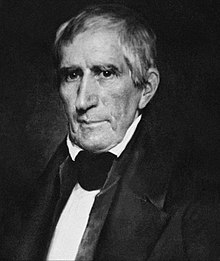William H Harrison
|
Major General William Henry Harrison |
|
|---|---|

A daguerreotype of Harrison in 1841
|
|
| 9th President of the United States | |
|
In office March 4, 1841 – April 4, 1841 |
|
| Vice President | John Tyler |
| Preceded by | Martin Van Buren |
| Succeeded by | John Tyler |
| United States Minister to Gran Colombia | |
|
In office May 24, 1828 – September 26, 1829 |
|
| President |
John Quincy Adams Andrew Jackson |
| Preceded by | Beaufort Taylor Watts |
| Succeeded by | Thomas Patrick Moore |
|
United States Senator from Ohio |
|
|
In office March 4, 1825 – May 20, 1828 |
|
| Preceded by | Ethan Allen Brown |
| Succeeded by | Jacob Burnet |
| Member of the U.S. House of Representatives from Ohio's 1st district |
|
|
In office October 8, 1816 – March 3, 1819 |
|
| Preceded by | John McLean |
| Succeeded by | Thomas R. Ross |
| Governor of the Indiana Territory | |
|
In office January 10, 1801 – December 28, 1812 |
|
| Appointed by | John Adams |
| President | John Adams Thomas Jefferson James Madison |
| Preceded by | Position established |
| Succeeded by | Thomas Posey |
| Member of the U.S. House of Representatives from the Northwest Territory |
|
|
In office March 4, 1799 – May 14, 1800 Delegate |
|
| Preceded by | Constituency established |
| Succeeded by | William McMillan |
| Constituency | At-large district |
| Secretary of the Northwest Territory | |
|
In office June 28, 1798 – October 1, 1799 |
|
| Governor | Arthur St. Clair |
| Preceded by | Winthrop Sargent |
| Succeeded by | Charles Willing Byrd |
| Personal details | |
| Born |
February 9, 1773 Charles City County, Colony of Virginia, British America |
| Died | April 4, 1841 (aged 68) Washington, D.C., United States |
| Resting place |
Harrison Tomb State Memorial North Bend, Ohio |
| Political party |
Democratic-Republican (1799–1828) Whig (1836–1841) |
| Spouse(s) | Anna Symmes (m. 1795) |
| Children | 10, including John Scott Harrison and Carter Bassett Harrison |
| Parents |
|
| Alma mater | |
| Profession | Military officer |
| Signature | |
| Military service | |
| Allegiance |
|
| Service/branch | |
| Years of service | 1791–1798, 1811, 1812–1814 |
| Rank | Major General |
| Unit | Legion of the United States |
| Commands | Army of the Northwest |
| Battles/wars | |
| The Harrison Cabinet | ||
|---|---|---|
| Office | Name | Term |
| President | William Henry Harrison | 1841 |
| Vice President | John Tyler | 1841 |
| Secretary of State | Daniel Webster | 1841 |
| Secretary of Treasury | Thomas Ewing | 1841 |
| Secretary of War | John Bell | 1841 |
| Attorney General | John J. Crittenden | 1841 |
| Postmaster General | Francis Granger | 1841 |
| Secretary of the Navy | George E. Badger | 1841 |
William Henry Harrison Sr. (February 9, 1773 – April 4, 1841) was the ninth President of the United States (1841), an American military officer, and the last president born as a British subject. He was 68 years, 23 days old at the time of his inauguration. He died of complications from pneumonia 31 days into his term, serving the shortest tenure in United States presidential history. He was the first president to die in office, and his death sparked a brief constitutional crisis. Its resolution left many unsettled questions following the presidential line of succession in regard to the Constitution until the passage of the Twenty-fifth Amendment to the United States Constitution in 1967. He was the grandfather of Benjamin Harrison, who served as the 23rd United States President from 1889 to 1893.
Before election as president, Harrison served as the first congressional delegate from the Northwest Territory and the first Governor of Indiana Territory. He gained national fame for leading U.S. forces against Native Americans at the Battle of Tippecanoe in 1811, where he earned the nickname "Tippecanoe" (or "Old Tippecanoe"). As a general officer in the subsequent War of 1812, his most notable action was in the Battle of the Thames in 1813. This battle resulted in the death of Tecumseh and the dissolution of the Indian coalition which Tecumseh had led.
After the war, Harrison moved to Ohio, where he was elected to the United States House of Representatives. In 1824, the state legislature elected him to the United States Senate. He served a truncated term after being appointed as Minister Plenipotentiary to Gran Colombia in May 1828. In Santa Fe de Bogotá, he spoke with president Simón Bolívar, urging Bolívar to guide his nation toward American-style democracy.
...
Wikipedia
